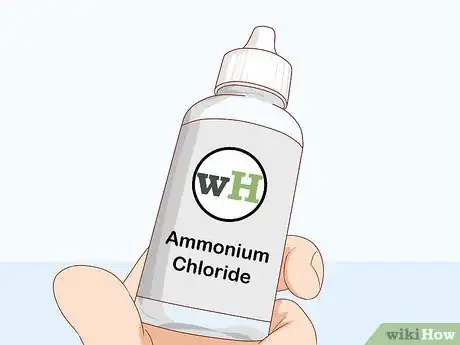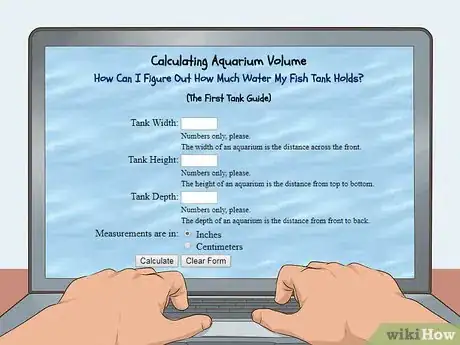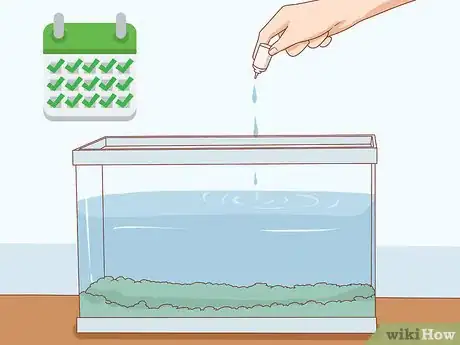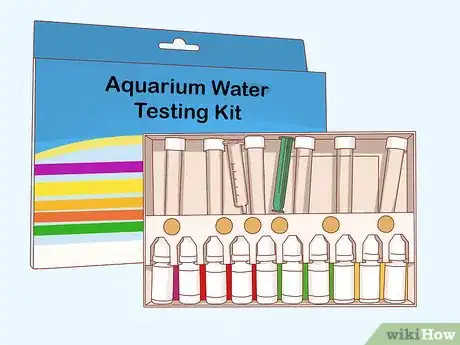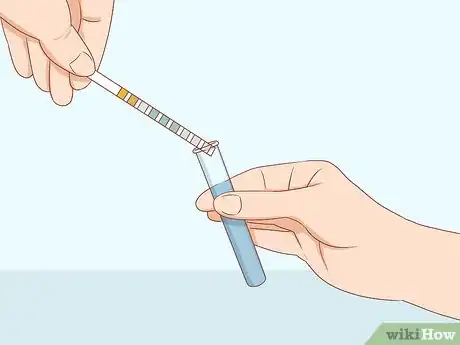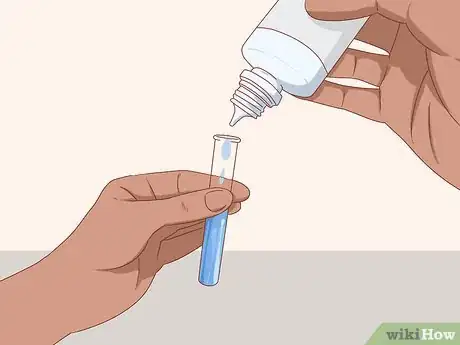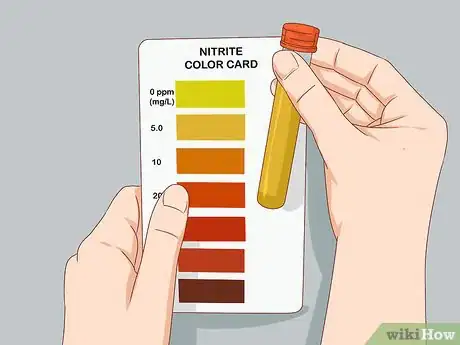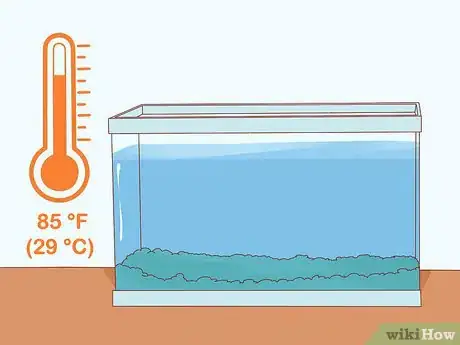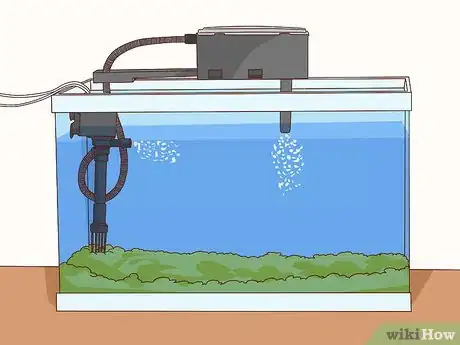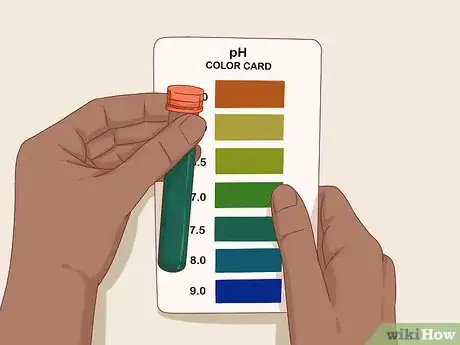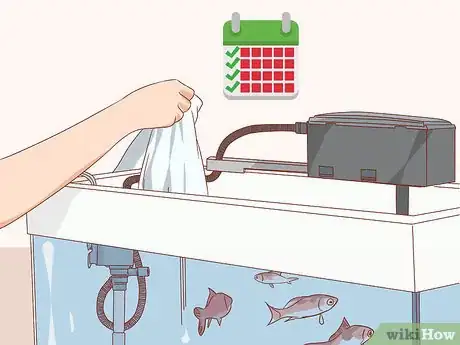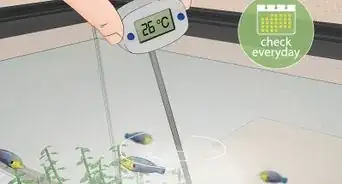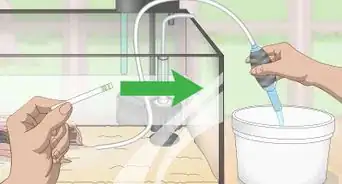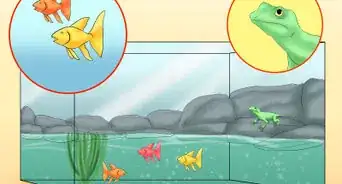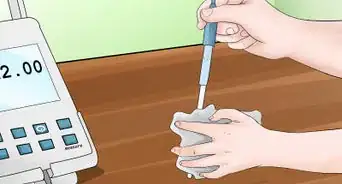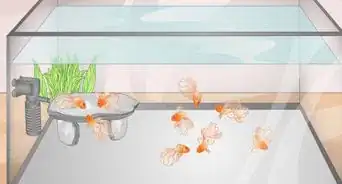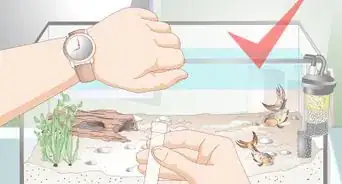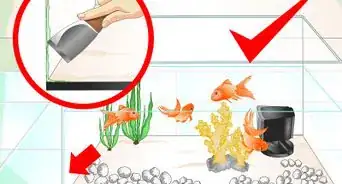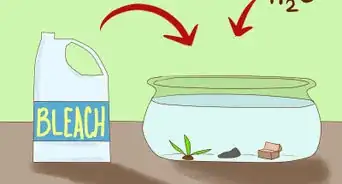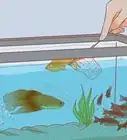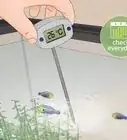This article was co-authored by Doug Ludemann. Doug Ludemann is the owner and operator of Fish Geeks, LLC, an aquarium services company based in Minneapolis, Minnesota. Doug has worked in the aquarium and fish-care industry for over 20 years, including having worked as a professional aquarist for the Minnesota Zoo and Shedd Aquarium in Chicago. He received his Bachelor of Science in Ecology, Evolution, and Behavior from the University of Minnesota.
There are 7 references cited in this article, which can be found at the bottom of the page.
wikiHow marks an article as reader-approved once it receives enough positive feedback. In this case, 100% of readers who voted found the article helpful, earning it our reader-approved status.
This article has been viewed 167,848 times.
New tank syndrome happens when the levels of ammonia and nitrites rise too high, harming fish. Often, this happens with a new tank because the filter hasn't developed the proper bacteria to deal with the ammonia and nitrites. To prevent new tank syndrome, the best solution is to mature the tank before you put the fish in. To mature the tank, you add ammonia to the water. That may sound counter-intuitive, but adding ammonia allows bacteria to develop that will remove the ammonia and nitrites from the water. Then, when your fish add ammonia to the water (through defecating), the bacteria will be able to remove it.
Steps
Adding the Initial Ammonia
-
1Use an aquarium ammonia mixed for this purpose. At pet stores, you can find products made for adding ammonia to a tank, specifically ammonium chloride. These products tell you exactly how much to add to the water, and are easy to use.[1]
- You can try Waterlife BioMature or DrTim's Aquatics Ammonium Chloride.
-
2Figure out how much water you have. Before you can determine how much ammonium chloride to add, you'll need to know how much water your tank holds.[2] If your tank is new, it should say how much it holds with the provided information. If you don't have that info, try a tank calculator like this one: http://www.firsttankguide.net/calculator.php
- You'll need the height, width, and depth of your tank for a calculator.
Advertisement -
3Add the recommended amount of ammonium chloride per day. Generally, you'll need to add a certain amount of ammonium chloride per day to the tank, specified on the back of the bottle. Sometimes, it's as little as 1 drop per gallon. If you figured out your tank size, add the appropriate amount per gallon of water in your tank.[3]
Monitoring and Adjusting the Levels of Ammonia
-
1Get an aquarium water testing kit. You can buy kits just for the chemicals you need to check, found online and at pet stores. However, sometimes it's easier to buy a master kit which will let you test for multiple chemicals. The two main types of kits are test strip kits and chemical drop tests.[4]
-
2Dip the provided test strips in tubes of the water. Pull out a test tube of water from the tank. Dip the test strip into the water, and pull it out. Wait for the strip to develop a color. Compare the color on the strip to the color ranges on the included cards to determine the chemical levels in your tank.[5]
-
3Add chemical drops to test tubes of tank water in a liquid test kit. With this kit type, which is an alternative to the test strip kit, you scoop out a test tube's worth of tank water. Read the directions on the back to check how many drops of the provided tester to add to the water, and add the drops. Put the lid back on, and shake it up.[6]
- Wait for the color to develop in the water, which happens within a few minutes. Compare the color to the color ranges on the provided cards to determine the chemical levels.
- You'll need a separate test tube to test for ammonia and nitrites.
-
4Aim for 5 to 10 milligrams in nitrites. If you're using ammonia chloride to add ammonia, you only need to test nitrites. Once the nitrites in your tank reach 5 to 10 milligrams, stop adding the ammonia. Keep testing the nitrites once a day. Once they drop to 0, you're ready to add fish.[7]
Speeding Up the Process and Adding Fish
-
1Keep the temperature around 85 °F (29 °C). The needed bacteria grow best when temperatures are warm but not too warm. A couple of degrees either way is fine, but try to keep the water in this range.[8]
- You can go as low as 77 °F (25 °C). You can do it in a coldwater tank, but it will take longer.
-
2Circulate the water. Of course, you'll need a water pump system for your fish. More vigorous pumps will help the bacteria grow faster, so if you're in a hurry, pick a pump that moves the water around at a rate of 5 times the amount your tank holds in an hour.[9]
- For instance, if your tank holds 20 gallons, it should be able to move 100 gallons (380 L).[10]
-
3Test the pH level.[11] The pH level also affects how quickly your tank will mature. Check the pH levels with a pH kit, which works similarly to the ammonia and nitrate kits. You dip a strip into water, and see what color it turns. Then you compare it to a chart.[12]
- The pH levels should be between 7.5 and 8 for ideal conditions.
- If you need to make the tank more acidic, you can add peat. If you need to make it more alkaline, you can add mineral salts (such as calcium).
- It you need to create an acidic tank, use a chemical filter instead of developing bacteria.
-
4Add fish after 2 to 4 weeks when the tank is ready. It takes a few weeks for the bacteria to properly develop in the tank. Be patient. Don't add the fish too soon, as you could end up with "new tank" syndrome. Just keep checking the chemical levels.[13]
Community Q&A
-
QuestionWhat if I already have fish (fry) in the tank, which will need to start eating, and the biological filter hasn't established since set up - still reading 0.25 ammonia? Is there anything that can jump start a cold water tank?
 Community AnswerYou can add filter media from a cycled aquarium to seed bacteria in your tank. You can also purchase the bacteria balls off eBay that I have heard good things about.
Community AnswerYou can add filter media from a cycled aquarium to seed bacteria in your tank. You can also purchase the bacteria balls off eBay that I have heard good things about. -
QuestionWhat should I do if my fish have been dying for the past three months?
 Community AnswerStop adding fish and allow the tank to cycle; this will take three weeks.
Community AnswerStop adding fish and allow the tank to cycle; this will take three weeks. -
QuestionWhat is required for a 10 gallon tank?
 Community AnswerIt depends on the type of fish. I assume you are talking about tropical freshwater fish, though, because those are the most common. In that case, get about a 50 watt heater, gravel, and plants/ornaments of your choosing. You will also want a hood light, pH testing kit, a gravel vacuum, and dechlorinator.
Community AnswerIt depends on the type of fish. I assume you are talking about tropical freshwater fish, though, because those are the most common. In that case, get about a 50 watt heater, gravel, and plants/ornaments of your choosing. You will also want a hood light, pH testing kit, a gravel vacuum, and dechlorinator.
References
- ↑ http://www.fishtanksandponds.co.uk/the-basics/maturing-aquarium.html
- ↑ Doug Ludemann. Aquarium Care Professional. Expert Interview. 27 August 2019.
- ↑ http://www.fishtanksandponds.co.uk/the-basics/maturing-aquarium.html
- ↑ https://www.fishlore.com/aquarium-water-test-kit.htm
- ↑ https://www.fishlore.com/aquarium-water-test-kit.htm
- ↑ https://www.fishlore.com/aquarium-water-test-kit.htm
- ↑ http://www.fishtanksandponds.co.uk/the-basics/maturing-aquarium.html
- ↑ http://www.fishtanksandponds.co.uk/the-basics/maturing-aquarium.html
- ↑ https://petcentral.chewy.com/fishless-aquarium-cycling-method/
- ↑ http://www.drsfostersmith.com/pic/article.cfm?articleid=280
- ↑ Doug Ludemann. Aquarium Care Professional. Expert Interview. 27 August 2019.
- ↑ https://petcentral.chewy.com/fishless-aquarium-cycling-method/
- ↑ https://petcentral.chewy.com/fishless-aquarium-cycling-method/
- ↑ https://petcentral.chewy.com/fishless-aquarium-cycling-method/
- ↑ http://www.fishtanksandponds.co.uk/the-basics/maturing-aquarium.html
About This Article
New Tank Syndrome happens when the levels of ammonia and nitrites rise too high, which can harm your fish. To avoid New Tank Syndrome, first, add an aquarium ammonia chloride mix to the water in your tank. This will allow healthy bacteria to build up, which will help regulate the amount of ammonia and nitrates in the water. Follow the instruction on the bottle to figure out how much you need to add. Then, use an aquarium test kit to measure the levels of ammonia in the water. Do this once a day until there are only 5-10 nitrates left in the water, which usually takes 2-4 weeks. To learn how to acclimate your fish to their new tank, read on!
